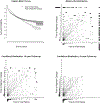Nonparametric estimation of Spearman's rank correlation with bivariate survival data
- PMID: 33704769
- PMCID: PMC8453584
- DOI: 10.1111/biom.13453
Nonparametric estimation of Spearman's rank correlation with bivariate survival data
Abstract
We study rank-based approaches to estimate the correlation between two right-censored variables. With end-of-study censoring, it is often impossible to nonparametrically identify the complete bivariate survival distribution, and therefore it is impossible to nonparametrically compute Spearman's rank correlation. As a solution, we propose two measures that can be nonparametrically estimated. The first measure is Spearman's correlation in a restricted region. The second measure is Spearman's correlation for an altered but estimable joint distribution. We describe population parameters for these measures and illustrate how they are similar to and different from the overall Spearman's correlation. We propose consistent estimators of these measures and study their performance through simulations. We illustrate our methods with a study assessing the correlation between the time to viral failure and the time to regimen change among persons living with HIV in Latin America who start antiretroviral therapy.
Keywords: HIV; Spearman's correlation; bivariate survival; nonparametric; viral failure.
© 2021 The International Biometric Society.
Figures





References
-
- Campbell G (1981) Nonparametric bivariate estimation with randomly censored data. Biometrika, 68, 417–422.
-
- Carriere JF (2000) Bivariate survival models for coupled lives. Scandinavian Actuarial Journal, 2000, 17–32.
-
- CCASAnet (2020). Times to viral failure and regimen change data. Anonymized for presentation, https://biostat.app.vumc.org/ArchivedAnalyses accessed March 17, 2021.
-
- Clayton DG (1978) A model for association in bivariate life tables and its application in epidemiological studies of familial tendency in chronic disease incidence. Biometrika, 65, 141–151.
Publication types
MeSH terms
Grants and funding
LinkOut - more resources
Full Text Sources
Other Literature Sources
Medical
Research Materials

